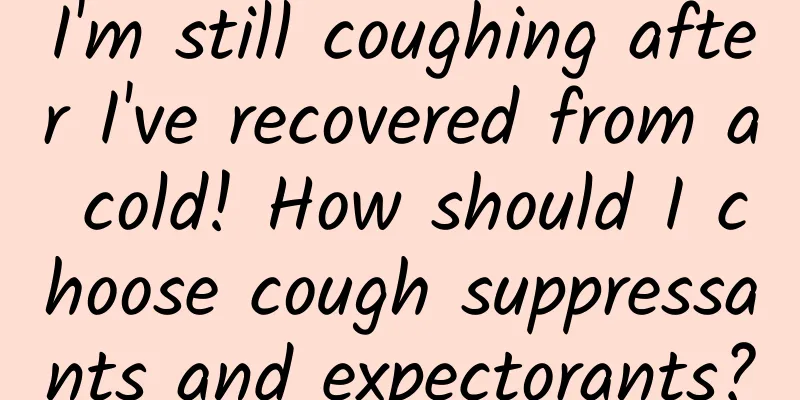I'm still coughing after I've recovered from a cold! How should I choose cough suppressants and expectorants?

|
Clinically, cough is the most common symptom in patients in respiratory specialist clinics and community clinics. In domestic specialist clinics, patients with chronic cough account for more than one-third. Cough can be caused by many reasons. The key to treatment is to treat the cause. Antitussive drugs can only temporarily relieve symptoms. Mild cough does not require antitussive treatment, but severe cough, such as severe dry cough or frequent cough that affects rest and sleep, can be appropriately given antitussive treatment . Patients with a lot of sputum should be treated with expectorants. 1. Antitussive drugs 1. Central antitussive drugs: This type of drug has an inhibitory effect on the medulla oblongata center. Depending on whether it has addictive and anesthetic effects, it can be divided into dependent and non-dependent antitussive drugs. Dependent antitussive drugs are morphine alkaloids and their derivatives, which have a very obvious antitussive effect. Due to their addictive nature, they are only used for a short period of time when other treatments are ineffective. Non-addictive antitussive drugs are mostly synthetic antitussive drugs, such as dextromethorphan and pentoxyverine, which are widely used in clinical practice . (1) Dependent cough suppressants ① Codeine : directly inhibits the medulla oblongata center, has a strong and rapid antitussive effect, and also has analgesic and sedative effects. It can be used to treat severe dry cough and irritating cough with unknown causes, poor treatment effects, especially dry cough accompanied by chest pain. Dosage and Administration: For adults, oral administration, 15-30 mg/time, 3 times/day; the maximum dose is 90 mg/time, 240 mg/day. Note: Long-term use may cause tolerance and addiction. Codeine-containing drugs are contraindicated for children under 18 years old ; contraindicated for patients with excessive sputum; contraindicated during pregnancy as it may cross the placenta and cause addiction to the fetus; not recommended for use during breastfeeding. ②Pholcodine : Its effects are similar to codeine, but its addictiveness is weaker. It is suitable for patients with severe dry cough accompanied by moderate pain. It has weak respiratory depressant effect and is not likely to cause constipation and digestive system disorders. Due to its advantages in efficacy and safety, it may be used as the first choice drug for lung cancer cough. Compound pholcodine oral solution/syrup is not only suitable for adults, but also for newborns and children. Dosage and Administration: For severe dry cough, adults can take 5-15 mg/time, 3-4 times/day, and the maximum dose is 60 mg/day. For severe dry cough in children, compound pholcodine oral solution can be used. For children under 2 years old, take 2.5 ml/time, 3-4 times/day; for children aged 2-6 years old, take 5 ml/time, 3-4 times/day; for children aged 6 years old and adolescents, take 10 ml/time, 3-4 times/day. Note: Occasionally nausea and drowsiness may occur. It may cause dependence. It is contraindicated for patients with excessive sputum. It should be used with caution during pregnancy and lactation. (2) Non-addictive cough suppressants ① Dextromethorphan : Currently, it is the most widely used antitussive drug in clinical practice. Its effects are similar to those of codeine, but it has no analgesic or hypnotic effects. The therapeutic dose has no inhibitory effect on the respiratory center and is not addictive. "Drug Use During Pregnancy and Lactation" lists dextromethorphan as the first choice for cough relief during pregnancy, but it is contraindicated in the early stages of pregnancy (first 3 months of pregnancy) . Using regular doses of dextromethorphan may not affect the baby, so breastfeeding is allowed normally. However, some preparations (such as dextromethorphan syrup) contain ethanol, so breastfeeding mothers should avoid using them. Dosage and Administration: For adults, take the single-dose preparation orally, 10-20 mg each time, once every 4-8 hours; for compound dextromethorphan, take 1-2 tablets each time, 3 times a day, and the maximum dose is 120 mg/day. For children, 2-6 years old, take 2.5-5 mg each time, 3-4 times a day; for children 6-12 years old, take 5-10 mg each time, 3-4 times a day. Note: Dextromethorphan can cause dizziness and drowsiness. It is more suitable for patients with night cough, but it is less effective for children with acute night cough. During medication, you should avoid driving, operating machinery and other dangerous operations. It is contraindicated for patients with a history of mental illness or those who have stopped using monoamine oxidase inhibitors for less than 2 weeks. ② Pentoxovir : The strength of the drug is 1/3 of that of codeine, and it also has anticonvulsant and antispasmodic effects. It is suitable for treating dry cough without sputum and whooping cough caused by upper respiratory tract infection, and its efficacy in children is better than that in adults. Dosage and Administration : Oral administration, tablets, 25 mg/time, 3-4 times/day for adults; 0.5-1 mg/kg/time, 2-3 times/day for children over 5 years old. Note : This product has no expectorant effect. It should be used together with expectorants for those with a lot of phlegm. Do not drive a plane, car, or boat, engage in high-altitude work, mechanical work, or operate precision instruments while taking the medicine. Use with caution in patients with glaucoma or heart failure. Use with caution during pregnancy or lactation. ③ Dextrorphan: It is a metabolite of dextromethorphan and is better tolerated by patients. It may replace dextromethorphan and be used in clinical treatment in the future. 2. Peripheral antitussive drugs (1) Narcotine : It is an isoquinolin alkaloid contained in opium. Its effects are equivalent to those of codeine, but it is non-addictive and has no inhibitory effect on the respiratory center. It is suitable for coughs caused by different reasons. Dosage and Administration : Adults, tablets 10-20 mg/time, 3 times/day; syrup 4-10 ml/time, 3-4 times/day. Note : Mild headache, drowsiness, and nausea may occur. It is not recommended for children, pregnant women, and breastfeeding women. Large doses may cause bronchospasm and should not be used for patients with excessive sputum or with other central nervous system stimulants. (2) Benproperine : a non-narcotic antitussive drug with an effect 2 to 4 times that of codeine. It can inhibit peripheral afferent nerves and cough centers. It is used to treat cough caused by acute and chronic bronchitis and various stimuli. It is suitable for patients with daytime cough and is also the first choice for severe cough. Dosage and Administration : Adults take orally, 20-40 mg each time, 3 times/d. Note : It has an anesthetic effect on the oral mucosa, causing numbness. The tablet should be swallowed whole and not chewed. Adverse reactions such as fatigue, dizziness, upper abdominal discomfort, lack of appetite, and rash may occur. It should not be used for coughs with a lot of sputum, and should be used with caution during pregnancy and lactation. (3) Benzonatate : It is a tetracaine derivative. For patients with mild chronic cough, benzonatate treatment can be tried (usually combined with dextromethorphan or used after trial treatment with dextromethorphan has failed). Dosage and Administration : For adults, take orally, 50-100 mg each time, 3 times/day. The maximum dose is 600 mg/day. Precautions : This product may cause nausea, dizziness, headache, sedation or drowsiness. The capsule should be swallowed whole. If the capsule is chewed or dissolved in the mouth, oropharyngeal anesthesia may occur. Use with caution during pregnancy. Conventional doses also have a significant risk of toxicity. It is contraindicated during lactation. (4) Moguisteine : A peripheral non-narcotic antitussive with a strong effect. This product is a peripheral antitussive with no effect on the central nervous system and is non-addictive. It is well absorbed orally, and its metabolites can be completely excreted from the body without accumulation. It is used to treat cough caused by acute and chronic respiratory diseases caused by infection, irritation, inflammation and tumors. Dosage and Administration : For adults, take orally 100-200 mg at a time, 3 times a day. For children, take as directed by a doctor. (5) Dioxin : A peripheral antitussive drug with multiple effects such as antitussive, antihistamine, and relieving smooth muscle spasm. It is mainly used for antitussive, but can also be used to treat allergic asthma, urticaria, and pruritus. Dosage and Administration : Oral administration, 5 mg each time for adults, 3 times/day. The maximum single dose is 10 mg, 30 mg/day. Note : There are adverse reactions such as drowsiness and fatigue. It is forbidden to use it for high-altitude work, driving vehicles, and operating machines. The therapeutic dose is close to the toxic dose and should not exceed the maximum dose. Use with caution in patients with epilepsy and liver dysfunction, and pregnant and lactating women. ### 2. Expectorant drugs Expectorants can improve the efficiency of coughing to clear airway secretions. There are many types of expectorants, and the common expectorants are as follows. 1. Guaifenesin The only expectorant drug approved by the U.S. Food and Drug Administration . It can stimulate the gastric mucosa, reflexively increase airway secretions, reduce sputum viscosity, and have a certain bronchial dilation effect, thereby enhancing mucus discharge. It is often used in combination with antihistamines, antitussive drugs, and decongestants. Dosage and Administration : Oral administration, tablets, 0.1-0.2 g per time for adults, 3-4 times/day; 15 mg per kg body weight per time for children, once every 6 hours. Syrup 10-15 mg per time, 3 times/day. 2. Myrtle Oil The extract of the leaves of the Myrtaceae family is a volatile plant oil that can promote the ciliary movement of the airway and sinus mucosa. It can be used for diseases such as acute bronchitis, chronic bronchitis and sinusitis. It is also suitable for bronchiectasis, chronic obstructive pulmonary disease, fungal lung infections, tuberculosis, silicosis, etc. It can also be used after bronchography to facilitate the excretion of contrast agents. Dosage and Administration: Oral administration. It is recommended to take it with plenty of cold boiled water 30 minutes before meals. Adults take standard myrtle oil (adult size) 300 mg/capsule. For acute patients, take 1 capsule (300 mg) 3 to 4 times a day; for chronic patients, take 1 capsule (300 mg) 2 times a day. Children aged 4 to 10 years old take standard myrtle oil enteric-coated capsules (children's size), 120 mg/capsule. Acute patients take 1 capsule (120 mg) 3 to 4 times a day; chronic patients take 1 capsule (120 mg) 2 times a day. Note: Myrtle oil rarely causes adverse reactions even in large doses. Very few patients may experience gastrointestinal discomfort, such as nausea, vomiting, diarrhea, etc., or cause the movement of existing kidney stones and gallstones. Occasionally, there may be allergic reactions, such as rash, facial edema, difficulty breathing and circulatory disorders. People who are not suitable for use: This product is not suitable for patients with inflammatory gastrointestinal diseases, biliary tract diseases, and severe liver diseases. It is strictly prohibited for children under 2 years old (including 2 years old children) to take this product. It is prohibited for those who are allergic to any ingredient of this product. 3. Ambroxol and Bromhexine Both are mucolytics, and ambroxol is the metabolite of bromhexine in the body. Both can be used for the expectorant treatment of acute exacerbation of chronic bronchitis, asthmatic bronchitis, bronchiectasis, and tracheal asthma. Injection can be used to prevent postoperative pulmonary complications and treat respiratory distress syndrome in premature infants and newborns. The recommended medication cycle is 7 days. Dosage and Administration: Ambroxol for injection: For adults and children over 12 years old, 2 to 3 times/d, 15 mg each time, slow intravenous infusion, in severe cases it can be increased to 30 mg each time; children aged 6 to 12 years old, 2 to 3 times/d, 15 mg each time, children aged 2 to 6 years old, 3 times/d, 7.5 mg each time; children under 2 years old, 2 times/d, 7.5 mg each time. Oral solution (preferably taken at mealtime): for adults and children over 12 years old, 10 ml each time, 2 times/day; for children aged 6-12 years old, 5 ml each time, 2-3 times/day; for children aged 2-6 years old, 2.5 ml each time, 3 times/day. For children aged 1-2 years old, 2.5 ml each time, 2 times/day. Tablets/capsules: Take after meals, 30 mg each time for adults, 3 times a day. Long-term use can be reduced to 2 times a day. Sustained-release capsules/sustained-release tablets: Take after meals, 75 mg each time for adults, once a day. Dispersible tablets: Take with liquid after meals. Adults take 30 mg each time (3 times/day) or 60 mg each time (2 times/day). The recommended dose for children is 1.2~1.6 mg/kg based on body weight. Orally disintegrating tablets: Place the tablet on the tongue without water or chewing. The tablet will disintegrate quickly and be swallowed into the stomach with saliva. For adults and children over 12 years old, take 30 mg each time, 3 times a day, after meals. Effervescent tablets: Orally dissolve in warm water, 30-60 mg for adults, 3 times a day. Children aged 6-12 years, 30 mg for children, 2-3 times a day. Ambroxol hydrochloride syrup (preferably taken at mealtime): for adults and children over 12 years old, 10 ml (2 tablespoons) each time, 2 times/d. For children aged 6-12 years old, 5 ml (1 tablespoon) each time, 2-3 times/d. For children aged 2-6 years old, 2.5 ml (1/2 tablespoon) each time, 3 times/d; for children aged 1-2 years old, 2.5 ml (1/2 tablespoon) each time, 2 times/d. This method is also suitable for the treatment of acute respiratory diseases and the initial treatment of chronic diseases. The dose can be halved after 14 days. Ambroxol hydrochloride solution for inhalation: For children over 12 years old and adults, 2-3 ml each time, inhaled 1-2 times a day (15-45 mg per day). For children aged 2-12 years old, 2 ml each time, inhaled 1-2 times a day (15-30 mg per day). For children aged 6 months to 2 years old, 1 ml each time, inhaled 1-2 times a day (7.5-15 mg per day). 4. Acetylcysteine It can break the sulfide bonds of mucus glycoprotein polypeptide chains, reduce the viscosity of sputum, and also has an antioxidant effect. It is used for patients with chronic cough with high mucus secretion and excessive sputum. Dosage and Administration : Spray inhalation: Before use, dissolve it with sodium chloride injection to make a 10%~20% solution, 1~3 ml at a time, 2~3 times/d. Tracheal instillation: 5% solution is instilled through the tracheal tube, or directly instilled into the trachea, 2 to 4 times/day. Infants can be instilled with 0.5 ml, children with 1 ml, and adults with 2 ml (but this method can only be used as an emergency measure, not as a routine medication). Oral administration: for adults, 0.2 g at a time, 2 to 3 times a day. For effervescent tablets, 0.6 g at a time, 1 to 2 times a day. 5. Carbocisteine Drugs used for symptomatic treatment of chronic bronchitis, bronchial asthma, pulmonary insufficiency and other diseases. Dosage and Administration : Carbocysteine tablets, oral, adults 2 tablets at a time, 3 times/d. Carbocisteine oral solution, oral, adults 10 ml at a time, 3 times/d. Carbocisteine granules, oral, adults 1 packet at a time, 3 times/d. References [1] Asthma Group, Chinese Society of Respiratory Diseases. Guidelines for the diagnosis and treatment of cough (2021)[J]. Chinese Journal of Tuberculosis and Respiratory Diseases, 2022, 45(1): 13-46. [2] Clinical Pharmacology Group of the Pediatrics Branch of the Chinese Medical Association, National Clinical Research Center for Child Health and Disease, Respiratory Group of the Pediatrics Branch of the Chinese Medical Association, etc. Clinical Practice Guidelines for Diagnosis and Treatment of Cough in Children in China (2021 Edition) [J]. Chinese Journal of Pediatrics, 2021, 59(9): 720-729. [3] Guo Liming, Wu Feng. Analysis of the causes of chronic cough[J]. International Journal of Respiratory Diseases, 2023, 43(8): 925-930. |
<<: Hot search! You may be eating this illegal meat product exposed by the 3.15 Gala
>>: It is called "black gold" and now 60% of the world's production comes from China!
Recommend
On the road of parenting, these 4 minefields must be avoided
Now, some parents have fallen into a big minefiel...
Talk about four kinds of App product designs that will never die if you don’t do it
[[120114]] 1. Superfluous products This kind of p...
The reason why there are so many mosquitoes has been found. Does the virus attract mosquitoes by regulating skin bacteria to produce "mosquito attractants"?
Great scientific discovery! Mosquitoes can actual...
What is Mobike’s user operation strategy?
I think you must be familiar with shared bicycles...
12306 electronic temporary identity card is now available! Official explanation: Apply in five simple steps
According to @中国铁路官方微信, starting today (January 1...
Video Network Promotion Methodology
According to iResearch mUserTracker data, in 2016...
How to promote App channels effectively? 3 stages!
APP channel promotion needs to go through three s...
Will Microsoft's "affair" with Qualcomm and Intel affect its status as the "first wife"?
There are no eternal friends or eternal enemies, ...
Epidemic & Capital, Analysis of the Self-help Case of the Medical Beauty Boss in a Short Video
In this cold winter of the epidemic, bosses shoul...
How much does it cost to produce a Zhengzhou beauty mini program?
How much is the quote for beauty makeup productio...
New media operation title guide: 5 methods and 3 practical skills
“A good title is half the work.” If you can choos...
Xiaomi TV head Wang Chuan: LeTV model is coming to an end
Introduction Wang Chuan, co-founder and vice pres...
How to promote 360 advertising information flow?
360 Promotion uses professional media promotion a...
What is "mirror life"? Why did 38 Nobel Prize winners scare them so much that they jointly banned its artificial synthesis?
On December 11, 2024, Science magazine published ...
Can the "dragon" and "phoenix" "combine"? The first dragon in Fujian with "bird wings" fills the gap of 30 million years!
On the 27th, it's time to kill the rooster! C...









